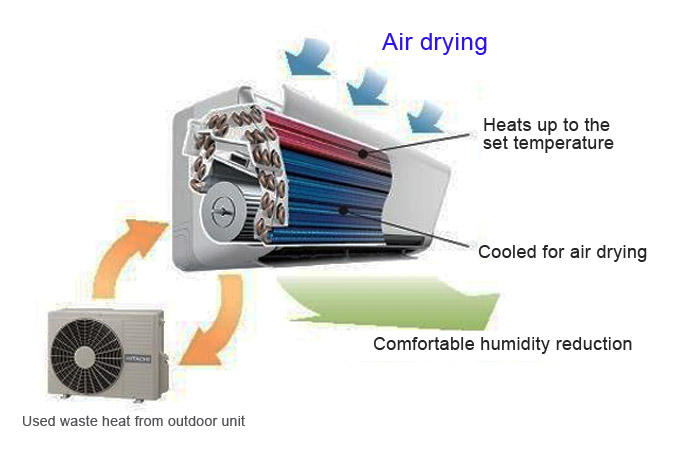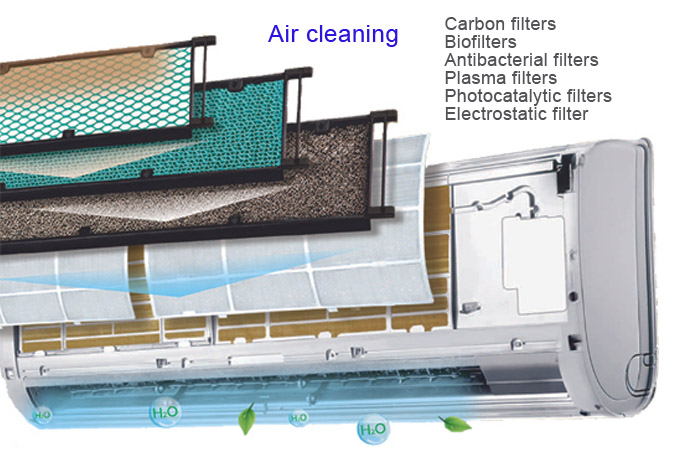An air conditioner (AC) has just one rightful counterpart – a refrigerator. Except it freezes its own guts and dumps heat into the outer environment (you can feel that if you hold your hand close to its back). An AC does almost the same thing, except it cools down the house and dumps excess heat outside. Vice versa, to heat up a room, it takes warmth from outside and transmits it inside.
Well, what does air conditioning do to carry heat from the cold outdoor environment into a well-heated room? There is no breach of the law of physics. It does these tricks of nature thanks to just two laws of nature.
First, when a liquid evaporates, it absorbs heat. If you are still not sure it does, spill a drop of gasoline, alcohol, or acetone onto your hand. Feels cold, doesn’t it. Vice versa, condensation results in the emission of heat. Now all we need to do is make a liquid boil at a low temperature and absorb heat, and condense at a high temperature. This can be achieved through the adjustment of pressure. To see how it works, you can climb high up a mountain. Because air pressure drops, it is no longer possible to boil a chicken leg up there, because water will boil at 70-75°C.
A split system features a compressor, which does the mountain’s job and creates a depression, which forces Freon to circulate. As it circulates, it is vaporized in the indoor unit and is changed back into a liquid in the outdoor one. In case you need to heat up the room instead of cooling it, the units will exchange roles. Window-mounted ACs work in a similar way, except all units are enclosed in a single box, part of which should project outside. Vice versa, a portable unit is used indoor only, and it dumps heat via corrugated hose that is run through the entrance door or a window. Now, back to the question: what does air conditioning do for your house?
-
- Definitely, cooling is an AC’s main function. Some companies still manufacture very simple models, which do nothing but that. However, there are advanced split-system ACs, which can do other things as well.
- Heating up rooms. Indeed, it is not advisable to set a split-system AC to the ‘heat’ mode when it is 30°C below zero outside. First, this would be useless: with outdoor temperature that low it will hardly do 40% of its nominal capacity. Second, the frost will cause oil in the compressor case to get thick and rob it of its properties, and every such use of the compressor will be worth several days of normal work in terms of wear-out. However, at -5°C to +10°C outside, there is nothing wrong with using the ‘heat’ mode. Unlike convectors, oil-filled heaters and fan heaters, modern split system ACs produces about 3 kWt of heat per 1 kWt of electricity consumed! There is no breach of the laws of physics, because the system spends energy on transfer of heat from one place to another, not on its production. The powerful fan located inside the indoor unit will not let hot air stay near the ceiling, so it will provide effective heating. And if you want your AC to keep you warm on a cold winter day, you can buy an AC with a built-in electric heating element. It will work as a blow heater, and the compressor will remain functional.
- Air drying. It is particularly important in summer, when it gets sultry before rain, and you can hardly take a deep breath without reducing humidity. It should be noted that ACs cannot maintain a particular humidity level, because they are not actually designed to. Not if you are conditioning an ATS, TV or radio station, computer room or other places filled with advanced electronic systems. This requires a special kind of HVAC systems.

- Air cleaning. Today, most ACs feature only one filter, which protects our lungs and the heat exchanger from dust, poplar down and other airborne debris. The air filter has to be rinsed out in warm water or vacuum-cleaned from time to time. Some brands offer models that come with high efficiency particulate air filters, which can catch 0.01 micron particles: dust, pollen, smells, cigarette smoke, etc. Their life span (they cannot be repaired) strongly depends on air pollution levels, and it rarely exceeds 3 to 4 months in a city environment.

